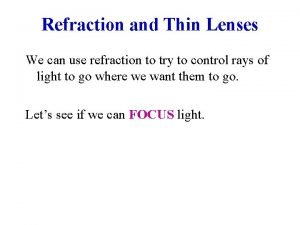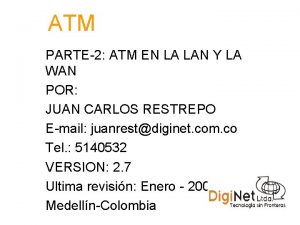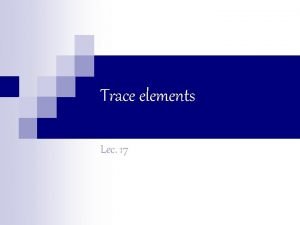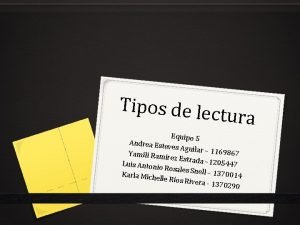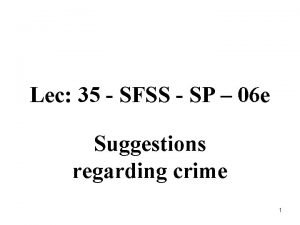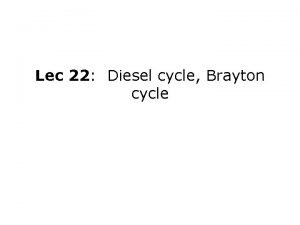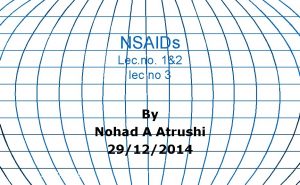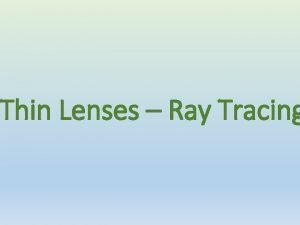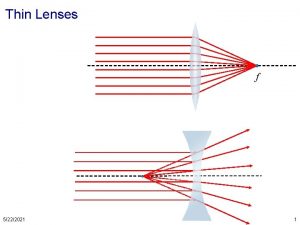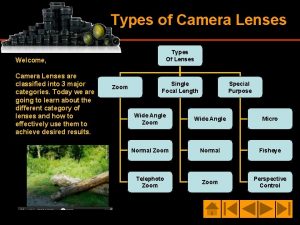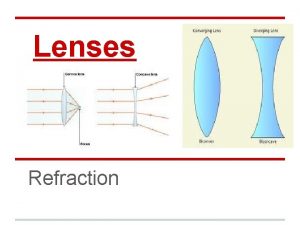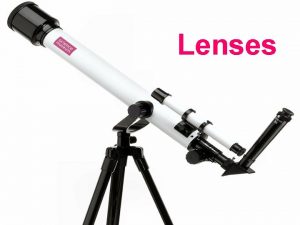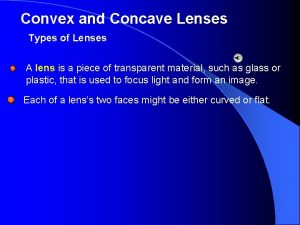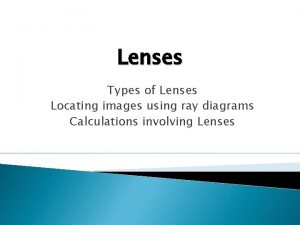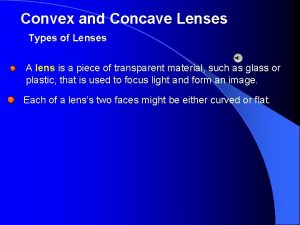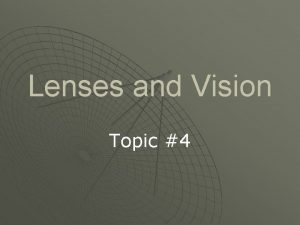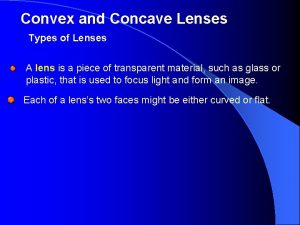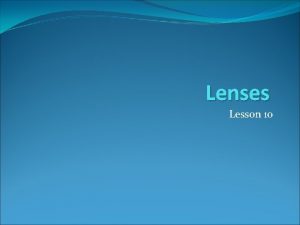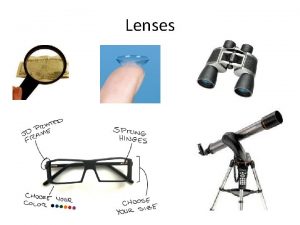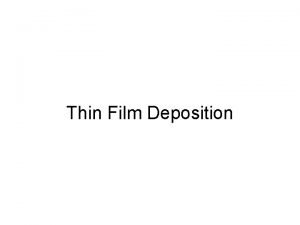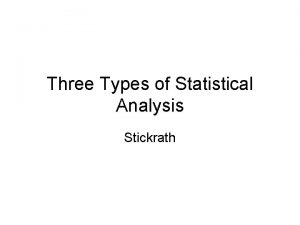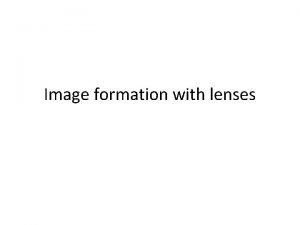Thin lenses Lec three Types of lenses A



























- Slides: 27

Thin lenses Lec. three

Types of lenses A thin lens may be defined as one whose thickness is • considered small in comparison with the distances generally associated with its optical properties. Such distances are, for example, radii of curvature of the two spherical surfaces, primary and secondary focal lengths, and object and image distances.

EXAMPLE 3 : A plano-convex lens having a' focal length of 25. 0 cm [Fig. 3 A(b)] curvature of is to be made of glass of refractive index n = 1. 520. Calculate the radius of the grinding and polishing tools that must be used to make this lens.

thin-lens equation, or the Lens maker’s formula As the rays travel from left to right through a lens, all convex surfaces are taken as having a positive radius and all concave surfaces a negative radius. For an equiconvex lens like the one in Fig. 3 A(a), r 1 for the first surface is positive and r 2 for the second surface negative. Substituting the value of l/f.

The combination of various surfaces of thin lenses will determine the signs of the corresponding spherical radii.

1

4. 1 FOCAL POINTS AND FOCAL LENGTHS Diagrams showing the refraction of light by an equiconvex lens and by an equiconcave lens are given in figure 4. 2. The axis in each case is a straight line through the geometrical center of the lens and perpendicular to the two faces at the points of intersection. For spherical lenses this line which joins the centers of curvature of the two surfaces. Ray diagrams shown in the figure 4. 2 illustrates the primary and secondary focal points F and F' and the corresponding focal lengths f and f' of thin lenses.


4. 2 CONJUGATE POINTS AND PLANES

are If we know the focal length of a thin lens and the position of an object, there three methods of determining the position of the image: (1) graphical construction, (2) experiment, and (3) use of the lens formula Here s is the object distance, s' is the image distance, and f is the focal length, all measured to or from the center of the lens. This lens equation will be derived later in this chapter.

4. 3 Sign Conventions for Thin Lenses 1: object distance (s) is positive if object is in front of lens and is a negative if object is in back of lens. 2: image distance (s') is positive if image is in back of lens and is negative if image is in front of lens. 3: r 1 and r 2 are positive if center of curvature is in back of lens. 4: r 1 and r 2 are negative if center of curvature is in front of lens. 5: focal length ( f ) is positive if the lens is converging and is negative if the lens is diverging. 2

4. 4 THE PARALLEL-RAY METHOD a: For Convex Lens Figure 4. 4 b: The parallel-ray method for graphically locating the image formed by a concave lens.

4. 5 LATERAL MAGNIFICATION A simple formula for the image magnification produced by a single lens can be derived from the geometry of figure 4. 4 a. By construction it is seen that the right triangles QMA and Q'M'A are similar. Corresponding sides are therefore proportional to each other, so that 3

1) construction graphically to determine state of image form in convex lens


4. 7 LENS MAKERS' FORMULA If a lens is to be ground to some specified focal length, the refractive index of the glass must be known. Supposing the index to be known, the radii of curvature must be so chosen as to satisfy the equation (4. 4) As the rays travel from left to right through a lens, all convex surfaces are taken as having a positive radius and all concave surfaces a negative radius. For an equiconvex lens, r 1 for the first surface is positive and r 2 for the second surface negative. Substituting the value of l/f from equation(4. 1), we can write If a lens is to be ground to some specified focal length, the refractive index of the glass must be known. Supposing the index to be known, the radii of curvature must be so chosen as to satisfy the equation (4. 5) As the rays travel from left to right through a lens, all convex surfaces are taken as having a positive radius and all concave surfaces a negative radius. For an equiconvex lens, r 1 for the first surface is positive and r 2 for the second surface negative. Substituting the value of l/f from equation(4. 1), we can write

4. 8 DERIVATION OF THE LENS FORMULA From similar triangles Q'TS and F' TA the proportionality between corresponding sides gives

Note that y - y' is written instead of y + y' because y', by the convention of signs, is a negative quantity. From the similar triangles QTS and FAS, The sum of these two equations is (4. 8) Since f = f ' , the two terms on the right can be combined and y - y' canceled out, yielding the desired equation, (4. 9) This equation is called Gaussian form or the lens equation of thin lenses, can be used to relate the image distance and object distance for a thin lens. Another form of the lens formula is the Newtonian form, is obtained in an analogous way from two other sets of similar triangles, QMF and FAS on the one hand TAF' and F'M'Q' on the other. We find (4. 10) Multiplication of one equation by the other gives

The newtonian lens formula then takes the symmetrical form The result is that the object and image must be on the opposite sides of their respective focal points. 4. 9 DERIVATION OF THE LENS MAKERS' FORMULA

". For this second surface the object ray T 1 T 2 has for its object distance s 2', and the refracted ray gives an image distance of s 2''. When the following equation determined in chapter 3 is applied to second refracting surface As a consequence we can set s 1' = - s 2' and write If we now call s 1 the object distance and designate it s as in figure (4. 8) and call s 2". the image distance and designate it s", we can write equation (4. 14) as

This is the general formula for a thin lens having different media on the two sides. By setting s or s" equal to infinity. When this is done, we obtain In words, the focal lengths have the ratio of the refractive indices of the two media n and n" , see figure(4. 8) (4. 17)

If the medium on both sides is the same, n = n" , equation (4. 15) reduces to Finally, if the surrounding medium is air (n = 1), we obtain the lens makers' Formula 4. 10 POWER OF LENS If the distances are measured in meter, the unit of power of lens is called diopter (D). the power of lens may be calculated by the relation

written as where P is the power of the lens and is equal to the sum of the powers of the two surfaces:

Examples EXAMPLE I: If an object is located 6. 0 cm in front of a lens of focal length + 10. 0 cm, where will the image be formed? The given quantities are s = + 6. 0 cm, and f = + 10. 0 cm, while the unknown quantities are s' and m. 1/s +1/s'= 1/f

Examples

EXAMPLE 3: A plano-convex lens having a' focal length of 25. 0 cm. is to be made of glass of refractive index n = 1. 520. Calculate the radius of curvature of the grinding and polishing tools that must be used to make this lens. SOLUTION: - Since a plano-convex lens has one flat surface, the radius for that surface is infinite, and r 1 in Eq. (4 d) is replaced by 00. The radius r 2 of the second surface is the unknown. Substitution of the known quantities in Eq.

EXAMPLE 4: - The radii of both surfaces of an equiconvex lens of index 1. 60 are equal to 8. 0 cm. Find its power. SOLUTION: n = 1. 60, r 1 = 0. 080 m, and r 2 = -0. 080 m (see table 1 and fig 1 for the shape of an equiconvex lens). power lens , radii and ﺍﻭ – ﺍﻣﺎﻡ ﻧﻮﺍﺗﺞ + ﺿﺮﻭﺭﻱ ﻭﺿﻊ ﻋﻼﻣﺔ : ﻣﻼﺣﻈﺔ object and image distance
 Refraction in thin lenses
Refraction in thin lenses Scoreboard architecture
Scoreboard architecture 11th chemistry thermodynamics lec 13
11th chemistry thermodynamics lec 13 Lec ditto
Lec ditto Scoreboarding computer architecture
Scoreboarding computer architecture Componentes del lec
Componentes del lec 11th chemistry thermodynamics lec 10
11th chemistry thermodynamics lec 10 Lec element
Lec element August lec 250
August lec 250 Underground pipeline for irrigation
Underground pipeline for irrigation Lec material
Lec material Apelacin
Apelacin Lec
Lec 132000 lec
132000 lec Xrl in 8051
Xrl in 8051 Tipos de lec
Tipos de lec Sekisui s-lec america llc
Sekisui s-lec america llc 416 lec
416 lec Lec
Lec Brayton cycle
Brayton cycle Lec promotion
Lec promotion Lec anatomia
Lec anatomia Lec hardver
Lec hardver Fenemates
Fenemates Lecsl
Lecsl Lec hardver
Lec hardver Lec renal
Lec renal 252 lec
252 lec
